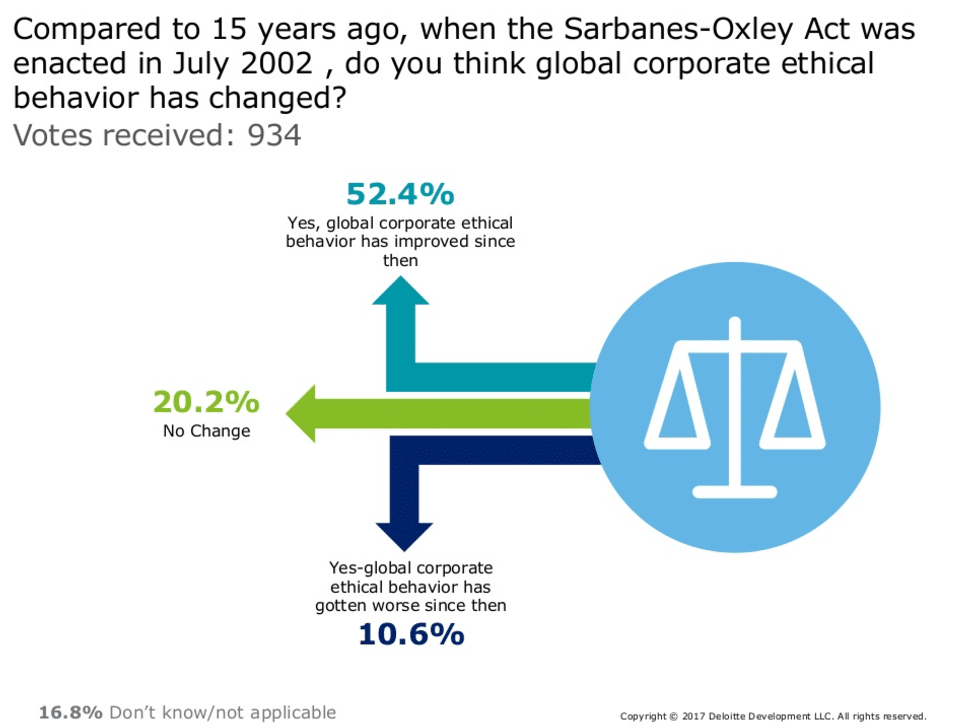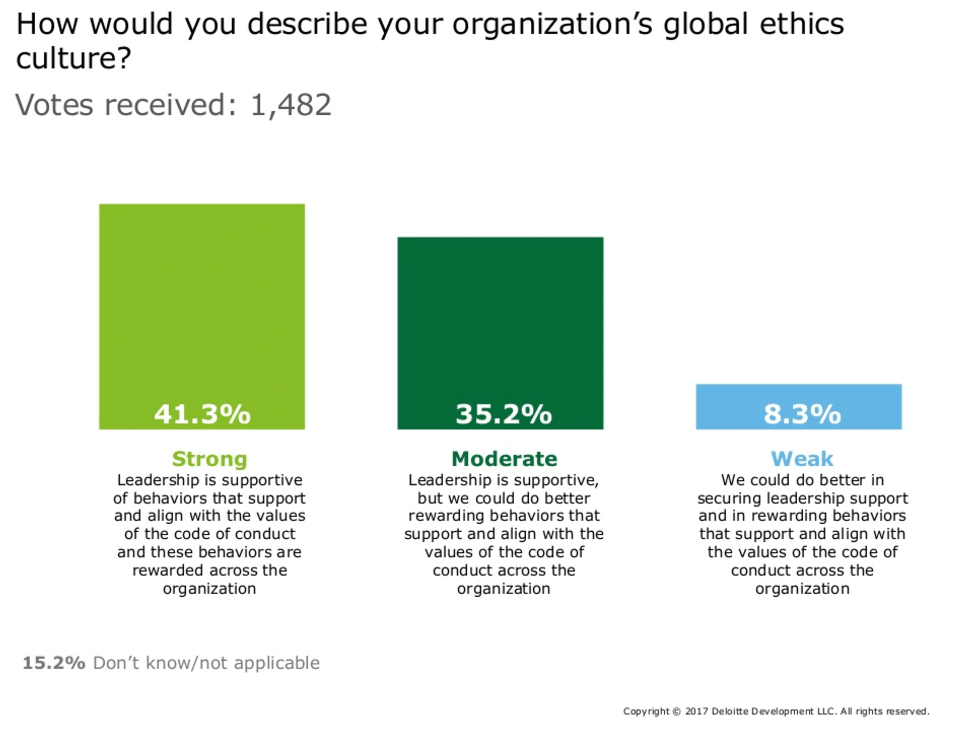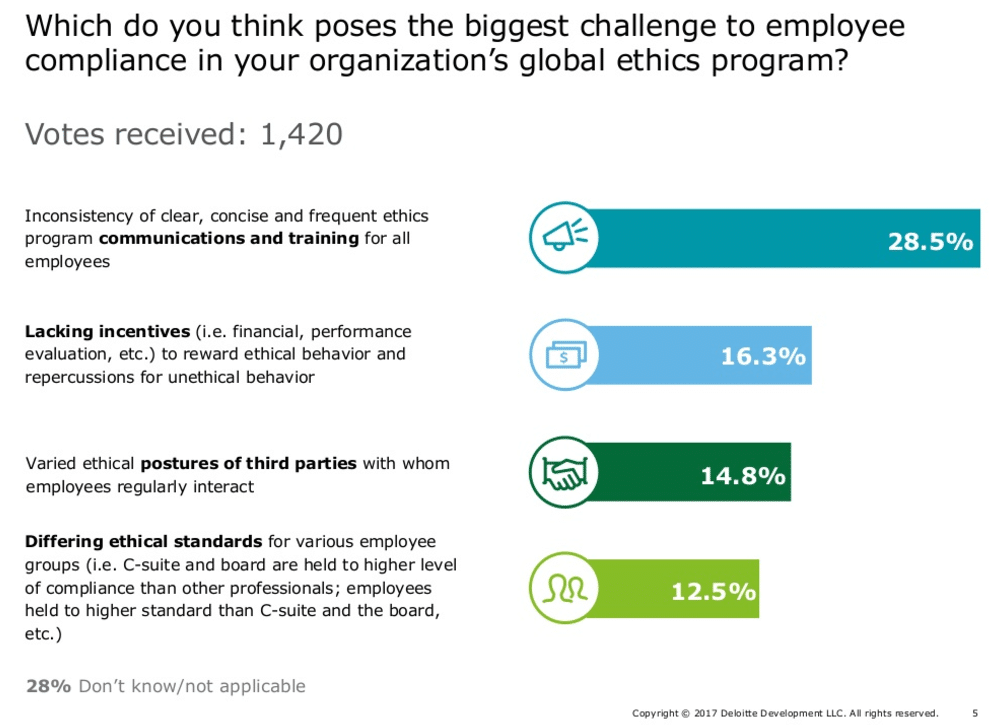Celebrating 15 years since the enactment of the Sarbanes-Oxley Act, more than half (52.4 percent) of C-suite and other executives say global corporate ethical behavior has improved since that milestone in July 2002, according to a recent Deloitte poll. Yet challenges clearly remain—only 41.3 percent of execs say their organizations’ global ethics cultures are strong.
“As we’ve seen for decades, no organization is immune to unethical behavior,” said Don Fancher, Deloitte Risk and Financial Advisory principal, in a news release. “But the field of ethics compliance is evolving, as professionals’ skillsets, technologies to help hone and monitor programs, and multi-jurisdictional regulator coordination all improve. Now is a great time for global organizations to take a hard look at modernizing their ethical compliance programs—particularly for those relying heavily on employees to report misconduct.”

Less than one-third (32.5 percent) of execs polled are highly confident their organizations’ employees will report unethical behavior. Executives say the biggest challenges to employees complying with global ethics programs include inconsistency of clear, concise and frequent ethics program communications and training for all employees (28.5 percent); lacking incentives and repercussions around ethical and unethical behavior, respectively (16.3 percent); varied ethical postures of third parties with whom employees regularly interact (14.8 percent); and, differing ethical standards for various employee groups (12.5 percent).

“Whether they need to monitor internal, external or both aspects of culture risk, we see leading companies leverage technology to modernize their compliance programs,” said Carey Oven, Deloitte Risk and Financial Advisory partner, in the release. “Some use cognitive solutions to identify anomalous employee behaviors. Others use advanced analytics to identify third-party patterns. The learnings from culture risk detection systems can help enhance the information leadership teams use to make decisions around ethics compliance policies and procedures.”

Questions to ask of your global ethics program include:
Do all leaders support the program?
Strong ethics programs are organization-wide with ongoing, full C-suite and board attention, as opposed to being managed by the general counsel or chief compliance officer alone. For example, chief accounting officers and CFOs can help unearth bribes, fraud and other illicit schemes that may be hiding in the books; or, by working with leaders across the C-suite, CISOs and CTOs can help discern what ethical weaknesses may lead to a higher frequency and intensity of cyberattacks.
Is the whistleblower hotline or speak-up line evolving?
The level, frequency, and type of reports via whistleblower communication channels can be telling. Testing—sometimes leveraging advanced analytics or other tools—can help discern reasonable levels of reporting and false positives, so that anomalous reports are more easily identified and more quickly investigated.
Are employees surveyed to gauge ethics culture?
By surveying employees about ethical standards and behaviors on an annual basis—as well as in exit interviews—organizations can make better informed updates to standards language, employee training and communications. Employee feedback can also help identify disparate subcultures in which interpretations of “ethical” behavior are inconsistent with the rest of the organization.
Is third-party due diligence conducted annually at minimum?
It’s not unusual to perform background checks around third parties upon entering into new contracts. But, personnel changes, financial strain, and other factors can change cultures quickly. Leveraging everything from annual third-party surveys to more covert social media analytics can help organizations understand with whom they’re doing business.
More than 930 c-suite and other executives responded to poll questions during the Deloitte Dbriefs webcast, “Global ethics and compliance in uncertain times: Leveling the playing field,” on May 24, 2017. Respondents largely work in the financial services (27.7 percent), consumer and industrial products (23 percent) and technology, media and telecommunications (9.1 percent) industries. Answer rates differed by question.







